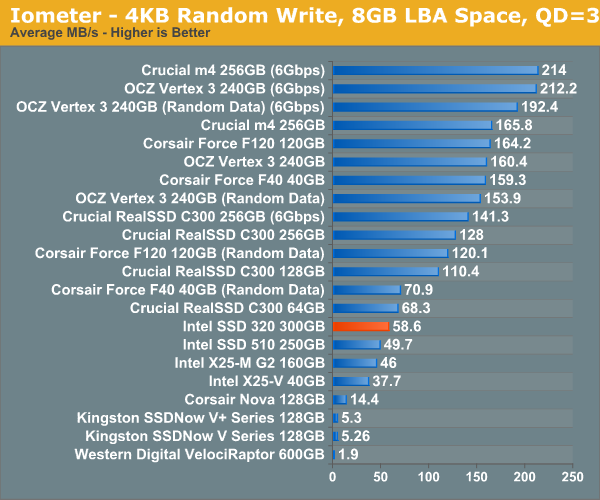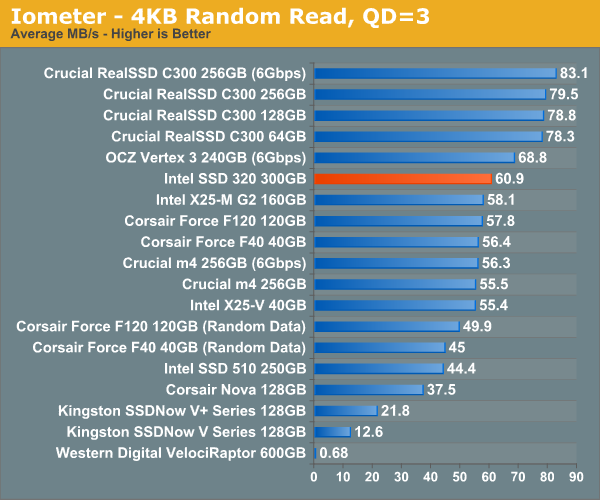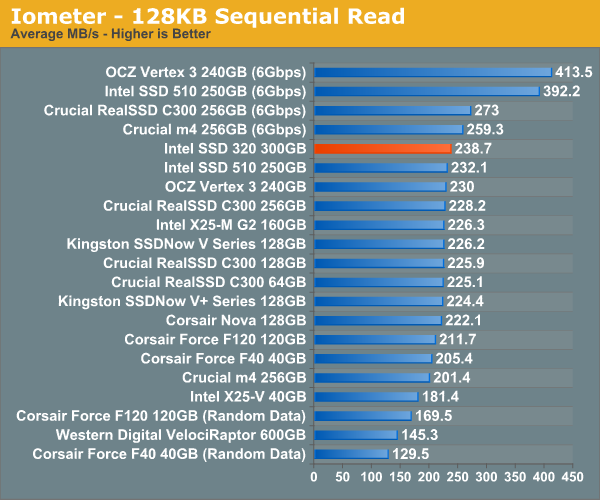The Intel SSD 320 Review: 25nm G3 is Finally Here
by Anand Lal Shimpi on March 28, 2011 11:08 AM EST- Posted in
- IT Computing
- Storage
- SSDs
- Intel
- Intel SSD 320
Random Read/Write Speed
The four corners of SSD performance are as follows: random read, random write, sequential read and sequential write speed. Random accesses are generally small in size, while sequential accesses tend to be larger and thus we have the four Iometer tests we use in all of our reviews.
Our first test writes 4KB in a completely random pattern over an 8GB space of the drive to simulate the sort of random access that you'd see on an OS drive (even this is more stressful than a normal desktop user would see). I perform three concurrent IOs and run the test for 3 minutes. The results reported are in average MB/s over the entire time. We use both standard pseudo randomly generated data for each write as well as fully random data to show you both the maximum and minimum performance offered by SandForce based drives in these tests. The average performance of SF drives will likely be somewhere in between the two values for each drive you see in the graphs. For an understanding of why this matters, read our original SandForce article.

Random write speed is improved compared to the 510 thanks to Intel's controller, but we're only looking at a marginal improvement compared to the original X25-M G2.
Many of you have asked for random write performance at higher queue depths. What I have below is our 4KB random write test performed at a queue depth of 32 instead of 3. While the vast majority of desktop usage models experience queue depths of 0 - 5, higher depths are possible in heavy I/O (and multi-user) workloads:


Random read performance has always been a strong point of Intel's controller and the 320 is no different. While we're not quite up to C300 levels, the 320 is definitely competitive here.
Sequential Read/Write Speed
To measure sequential performance I ran a 1 minute long 128KB sequential test over the entire span of the drive at a queue depth of 1. The results reported are in average MB/s over the entire test length.

Without a 6Gbps interface the 320's performance is severely limited. Compared to other 3Gbps drives the 320 is quite good here though.

Read performance is at the top of the chart for 3Gbps drives. I wonder how far Intel would've been able to push things if the 320 had a 6Gbps controller.










194 Comments
View All Comments
semo - Monday, March 28, 2011 - link
Anand, it has been a long time now. People are still confused about what is happening with the OCZ V2 drives. OCZ are still not issuing a recall of drives that are smaller and slower than what the packaging claims.OCZ will only react when the customer finds out through their own research what has happened and then confronts OCZ.
For those wanting to know more, see my thread below or research the OCZ Vertex 2 25nm transition fiasco.
http://forums.anandtech.com/showthread.php?t=21433...
The issue will not be resolved until OCZ recalls all affected products.
GeorgeH - Monday, March 28, 2011 - link
It looks like the crucial parts are physically identical to G2 drives. Intel may not offer updated firmware for G2 drives, but it looks like it might not be impossibly difficult to modify G3 firmware to work on G2 drives.Did Intel give any indication if the G2 controllers were physically different from the G3s? In other words did Intel take the laser scalpel to the G2 controllers or is it just a software restriction?
Chloiber - Monday, March 28, 2011 - link
Anand explained why the write performance is higher (4kB -> 8kB).GeorgeH - Monday, March 28, 2011 - link
Sure, but full disk encryption might be nice.Anand Lal Shimpi - Monday, March 28, 2011 - link
The G2 controller had the same features as the 320's controller. It's unclear whether they were tested/functional in the G2 era but they were there. The 320's controller is apparently the same physical die, just with these new features enabled/tested/validated.G1 owners didn't get TRIM, and I wouldn't expect G2 owners to get AES-128 via firmware. Sorry :(
bbbcase - Monday, March 28, 2011 - link
The Intel G1/G2 drives would eventually throttle write performance if you consistently wrote over 20GB/day on them to ensure warranty lifetime. This really limited their usefulness in certain server applications.Does the G3 have a similar throttling mechanism?
Chloiber - Monday, March 28, 2011 - link
?? They didn't. The block fragmentation will, in spite of TRIM increase (that's the case with pretty much every SSD). Write 0s sequentially on the empty space every 2 months and the performance will always be as it was on the first day.You can also do this by doing a Full Diagnostics Scan using the Intel SSD Toolbox (writes sequentially on the empty space).
toyotabedzrock - Monday, March 28, 2011 - link
I'm curious if a 8KB random R/W test would show a bump in speed beyond what other drives would see.Intel really needs to get serious about allocating people to the SSD and Chipset teams. They always make a quick leap with a great new chip then it languishes for years with minor updates.
Pentium 4 flashbacks!
cdbob - Monday, March 28, 2011 - link
I heard rumors that pricing was going to be on the steep side. It's too bad this turned out to be true, Intel better lower the price of their drives quick or they're going to start eating some serious dust when the next crop of Crucial Drives come out.Beenthere - Monday, March 28, 2011 - link
That's why I won't buy any SSD for at least five more years. Poor reliability and data loss don't work for me.